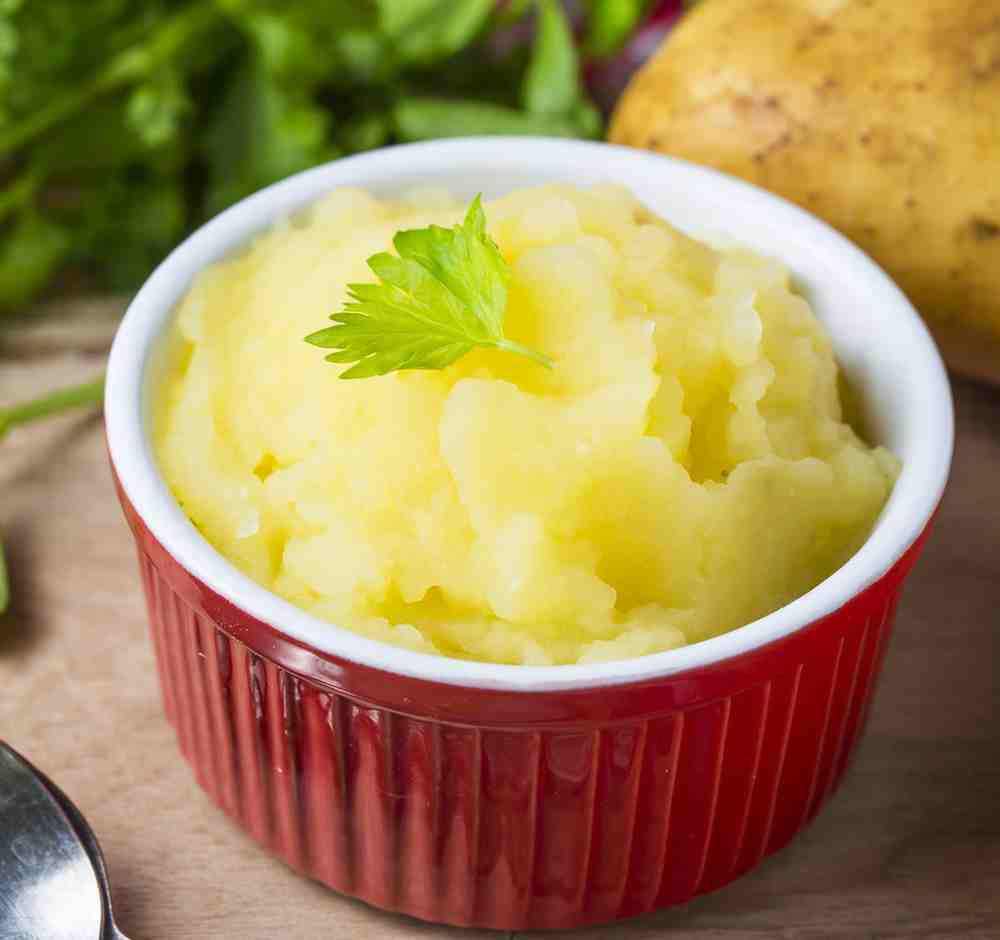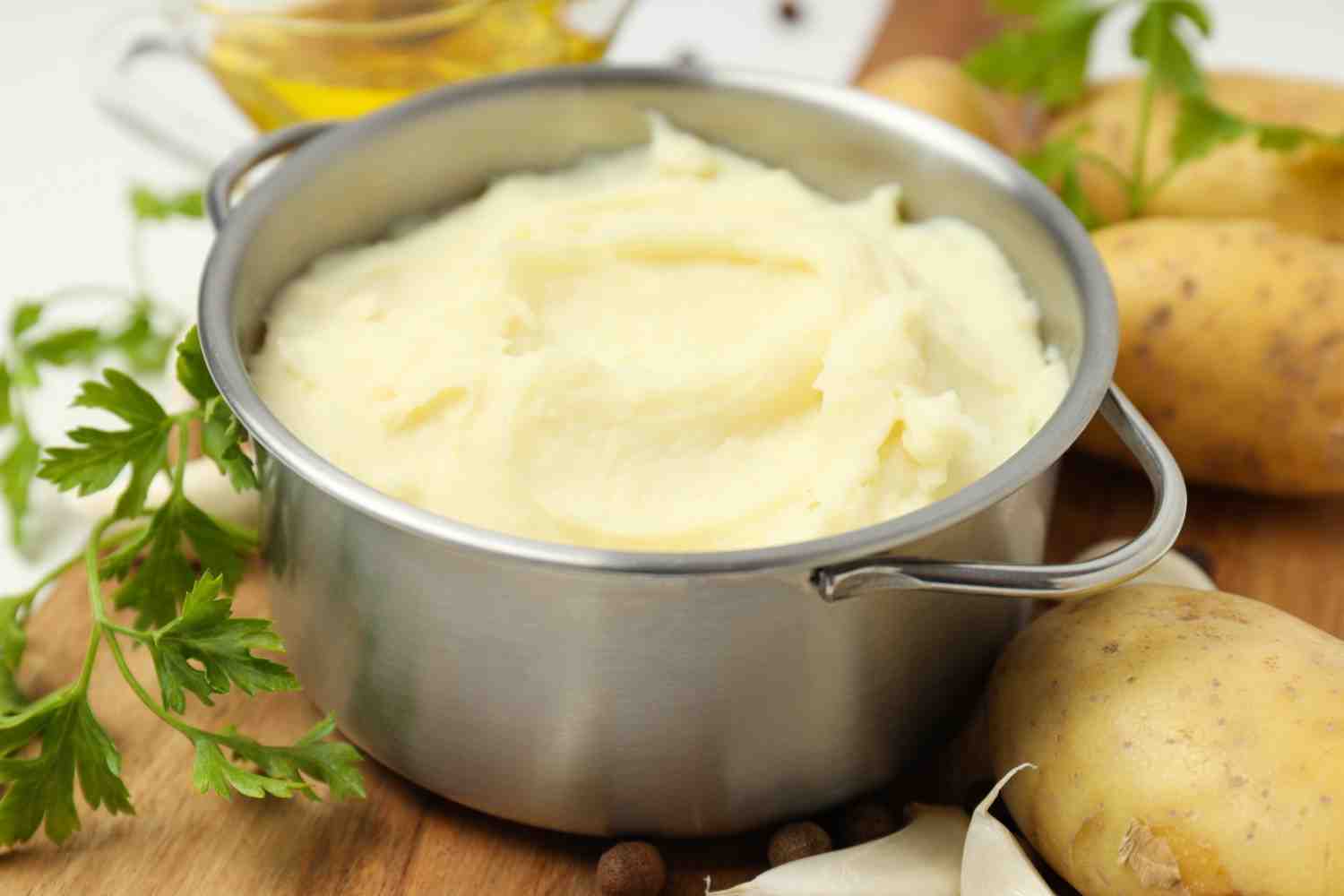French potato purée is a luxurious side dish known for its rich, smooth texture. Unlike traditional mashed potatoes, purée is velvety and refined, making it a popular choice in gourmet kitchens worldwide. This guide covers everything you need to know to make the perfect potato purée, from selecting the right potatoes to mastering the French technique that guarantees a flawless finish.
What is the Difference Between Mashed Potatoes and Potato Purée?
French potato purée may seem similar to mashed potatoes, but key differences set them apart.
Texture and Consistency
Potato purée offers a smoother, silkier texture compared to the more rustic consistency of mashed potatoes. This difference results from the method and tools used. Purée requires a potato ricer or food mill, creating a light and airy texture. In contrast, mashed potatoes often rely on a standard masher, leaving behind small lumps and a chunkier finish.
Ingredients and Techniques
The richness of French purée comes from generous amounts of butter and cream. Traditional recipes include cold butter and warm milk or cream, contributing to the smooth texture. Making purée also requires careful handling to prevent overworking the potatoes, which can release too much starch and make the mixture gluey.
Culinary Uses
Purée complements high-end dishes like steak au poivre, roasted chicken, or braised meats, where a smooth, creamy side is desired. It pairs well with rich sauces, as the purée can absorb the flavors beautifully. Meanwhile, mashed potatoes fit well with more rustic meals like fried chicken, meatloaf, or holiday dinners.
Which Potatoes Are Best for Purée?

Choosing the right potato variety is essential for achieving a perfect purée. Different potatoes vary in starch and moisture levels, directly affecting the final texture.
Selecting the Right Variety
Starchy potatoes like Yukon Gold or Russet work best for creating a creamy purée. These potatoes absorb butter and cream efficiently, ensuring a smooth and cohesive texture. Yukon Gold potatoes are particularly favored in French cuisine for their naturally buttery flavor and golden color. Russets, known for their high starch content, produce a fluffy, light result.
Moisture Content and Its Impact
Starchier potatoes, with lower moisture content, create the thick, silky consistency that defines a great purée. High-moisture potatoes, like Red Bliss or fingerlings, can result in a watery and less desirable texture. Choosing the right potato helps maintain the ideal balance between thickness and smoothness.
Avoiding a Gluey Texture
One common mistake when making purée is overworking the potatoes. This process releases too much starch, which leads to a gluey consistency. Avoid using a food processor or immersion blender, as these tools break down the starches excessively. A potato ricer or food mill gently mashes the potatoes, preserving their light, airy nature.
French Master Recipe: Making the Best Potato Purée
To create an exceptional French potato purée, follow this classic recipe, focusing on balance and technique.
Ingredients and Essential Tools
- 2 ¼ pounds of Yukon Gold or Russet potatoes
- 6 ounces of cold, unsalted butter, cut into small pieces
- 1 cup whole milk or heavy cream, warmed
- Coarse salt, to taste
- Potato ricer or food mill
- Wooden spoon and large saucepan
Step-by-Step Process
- Boil the Potatoes: Peel and cut the potatoes into even-sized chunks. Place them in a large pot of salted cold water and bring to a boil. Cook until the potatoes become tender enough to pierce with a knife, about 20 minutes.
- Drain and Rice the Potatoes: Drain the potatoes thoroughly and rice them immediately while hot. This method maintains a light texture and prevents the potatoes from becoming gummy. Work quickly to ensure they stay warm.
- Incorporate Cold Butter: Transfer the riced potatoes back into the pot. Gradually add the cold butter, stirring vigorously with a wooden spoon until each piece melts and incorporates before adding the next. This step builds a rich, creamy base.
- Add Warm Milk or Cream: Pour the warm milk or cream into the mixture slowly, stirring continuously until a smooth, velvety consistency forms. Add the liquid in small increments to avoid a runny purée.
- Season and Adjust: Taste and adjust the seasoning with salt. If the purée feels too thick, add more warm milk until it reaches the desired consistency.

Tips for Extra Smooth Purée
- Keep the potatoes hot while ricing to prevent lumps.
- Use cold butter for better emulsification, leading to a silky finish.
- Stir vigorously but avoid excessive mixing to maintain a smooth texture.
Adjusting the Consistency
- Add milk or cream gradually for better control over thickness. The goal is to achieve a purée that holds its shape but flows easily off a spoon.
- Use less butter and more milk for a lighter purée, or increase the butter for a richer result.
Maintaining the Purée’s Quality
- Use a bain-marie (hot water bath) to keep the purée warm before serving, preventing it from drying out or losing its smoothness.
- Place a small pat of butter on top to prevent a skin from forming if the purée needs to stay warm for an extended period.
Techniques, Tips, and Secrets
Continuing our deep dive into the art of creating the perfect French potato purée, this part focuses on enhancing the dish with creative variations, serving suggestions, and answering common questions that arise when making this luxurious side dish.
How to Make the Best Purée?
Achieving a flawless potato purée involves more than just following a recipe. The secret lies in understanding key techniques and avoiding common pitfalls. Here’s how to take your purée to the next level:
Secrets to Achieving the Perfect Texture
- Maintain the Right Temperatures: Keep the potatoes hot while processing them, which helps to prevent lumps. Similarly, ensure that the milk or cream is warm before incorporating it into the purée. This method ensures that the butter blends smoothly and the purée stays light.
- Use High-Quality Ingredients: The flavor of French potato purée depends heavily on the quality of the butter and cream. Consider using European-style butter with higher fat content, such as French or Irish butter, for a richer taste.
- Incorporate Butter Gradually: Adding small pieces of cold butter gradually creates an emulsion, resulting in a silky, creamy purée. This technique helps integrate the butter without overwhelming the mixture.
Enhancing Flavor
- Infusing Cream: Infuse the cream with garlic, thyme, or rosemary before adding it to the potatoes. Simply simmer the herbs in the cream for a few minutes, strain, and then mix the warm, flavored cream into the purée.
- Adding Spices: Although traditional French purée sticks to basic seasoning, a touch of freshly grated nutmeg or white pepper can add depth. Use sparingly to maintain the purée’s classic profile.
- Adjusting Salt: Salt is essential for bringing out the flavor in potato purée. Taste the purée at every stage and adjust the salt gradually until it complements the richness of the butter and cream.
Common Mistakes to Avoid
- Over-Mixing: Stirring or blending the purée too much releases starch, creating a gluey texture. Mix gently with a wooden spoon or spatula and avoid using an immersion blender.
- Using the Wrong Potato Variety: Opting for waxy potatoes instead of starchy ones can result in a watery purée. Stick with Yukon Gold or Russet potatoes for the best results.
- Not Ricing the Potatoes When Hot: Cold potatoes can become clumpy when riced, so process them immediately after boiling to ensure a smooth purée.
Creative Variations of French Potato Purée
While the classic French potato purée is a timeless favorite, adding a personal twist can make it even more special. Here are a few creative variations:
Infused Creams
- Garlic-Infused Cream: Heat the cream with a few crushed garlic cloves, then strain before mixing it into the purée. The subtle garlic flavor complements the rich, buttery base.
- Herb-Infused Cream: Add fresh thyme, rosemary, or bay leaves to the milk or cream as it warms. Let the herbs steep, then strain and mix for a fragrant purée.
Healthier Versions
- Olive Oil Purée: Replace half of the butter with high-quality extra virgin olive oil for a lighter version. This change adds a fruity, aromatic note while reducing saturated fat.
- Low-Fat Milk Substitution: Use low-fat milk instead of whole milk or cream to create a lighter, lower-calorie version of purée. The texture may be slightly less rich but remains smooth.
Vegan Potato Purée
- Plant-Based Cream: Use oat milk or cashew cream as a dairy alternative. These options add a creamy consistency without compromising the texture.
- Vegan Butter: Replace the cold butter with vegan margarine or coconut oil, adjusting the quantities to maintain the desired creaminess.
Serving Suggestions: Perfect Pairings for French Potato Purée

Potato purée pairs beautifully with a variety of dishes, adding a touch of elegance to any meal. Here’s how to serve it in style:
Classic French Dishes
- Steak au Poivre: The smooth, rich purée complements the peppery crust and tender texture of a perfectly cooked steak au poivre.
- Braised Lamb Shanks: Serve the purée alongside slow-cooked lamb shanks for a hearty and luxurious meal. The purée absorbs the rich braising juices, enhancing the flavors.
- Roasted Chicken: Pair the purée with a simple, herb-roasted chicken to elevate a classic comfort meal.
Modern Serving Ideas
- Base for Vegetarian Mains: Use potato purée as a base for roasted vegetables or vegetarian stews. Its creamy texture adds a satisfying element to plant-based dishes.
- In a Small Bowl for Tasting Menus: Serve small portions of purée in individual ramekins as part of a multi-course tasting menu, offering a luxurious touch to each course.
- Layered in Casseroles: Use purée in place of mashed potatoes in dishes like shepherd’s pie, creating a silkier and more refined top layer.
Elegant Plating Techniques
- Spoon-Swiped Presentation: For a restaurant-style look, spoon a portion of purée onto a plate and swipe with the back of a spoon to create a smooth, curved design.
- Piped for Visual Appeal: Use a piping bag with a large round tip to create decorative mounds of purée on the plate. This method adds elegance to any dish.
- Circular Molds: Use a round mold to form neat circles of purée on the plate, then top with a piece of fish or meat for a polished presentation.
FAQs About French Potato Purée
Why is my potato purée gluey?
- Overworking the potatoes or using a blender can cause a gluey texture. Always use a potato ricer and mix gently with a spoon.
Can I use a blender for potato purée?
- It’s best to avoid blenders, as they can over-process the potatoes, releasing excess starch. A ricer or food mill works better for maintaining a smooth texture.
How do you reheat French potato purée?
- Reheat purée gently over low heat on the stovetop, stirring in a splash of milk or cream to restore its smoothness.
Is potato purée healthier than mashed potatoes?
- The purée contains more butter and cream, making it richer in calories than traditional mashed potatoes. However, it offers a luxurious texture that’s perfect for special occasions.
Can I freeze potato purée?
- While it’s possible to freeze purée, it can become grainy when reheated. To preserve the texture, add extra cream when reheating to restore its smoothness.
What makes a good French potato purée?
- A good purée is smooth, creamy, and free of lumps. Achieving this requires the right potato variety, proper technique, and high-quality ingredients.
How long can you store potato purée in the fridge?
- Store purée in an airtight container in the refrigerator for up to 3 days. Reheat with a little extra cream or milk to bring back its smooth consistency.
Should I peel potatoes for purée?
- Yes, peeling the potatoes helps achieve a smoother texture. Skins can add lumps and interfere with the desired creamy consistency.

